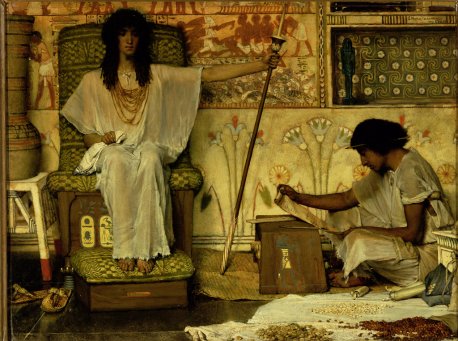Joseph, Overseer of Pharaoh's Granary
Hieroglyphs
Joseph, Overseer of Pharaoh's Granary [ edit ]
A child prodigy, member of the Academy of Fine Arts in Antwerp, and a celebrated artist of Victorian England, Sir Lawrence Alma-Tadema achieved life-long success as a painter whose canvases re-created historical scenes with vibrancy, intimacy, and realism. The archaeological details and accurate architectural forms within Alma-Tadema’s large oevre appear in his Greek and Roman themed works as well as his Egyptianizing paintings. A close friend of Egyptologist Georg Moritz Ebers, both men “sought to reveal an antiquity based on ancient sources rather than on modern fantasies and preconceptions” (Barrow, Lawrence Alma-Tadema, p. 27).
The vibrant details and subtle gilded effects of Joseph, Overseer of Pharaoh’s Granaries (1874) draws the viewer into a room with an important official, seated on a cushioned chair, as his scribal assistant sits cross-legged to the right. This high-ranking official is the Biblical Joseph, whose dream-interpreting abilities allowed him to ascend from foreign slave to vizier, the king’s chief adviser. Joseph’s authority and the opulence of his surroundings and dress are well evident, from the colorful paintings and on the wall behind him to his elaborate wig, necklaces, and sandals (lying discarded on the far left). The cartouches (name ring) of the pharaoh Thutmose II (r. ca. 1492-1479 BCE) appear on the throne just to the left of Joseph’s legs, and the Biblical story explains that the pharaoh “dressed him (Joseph) in robes of fine linen and put a gold chain around his neck” (Genesis 41: 42) as symbols of Joseph’s authority over the land of Egypt.
Joseph’s interpretation of pharaoh’s dream as seven years of plenty followed by seven years of famine led to a nation-wide policy of grain storage, and due to Joseph’s foresight Egypt’s storehouses fed the hungry during the lean years. In Lawrence Alma-Tadema’s imagining of Joseph’s Egypt, scribes, their divine patron, and writing all appear prominently. To capture Joseph’s administrative abilities, Alma-Tadema chose one facet of the vast supply-collecting enterprise: a single scribe recording small piles of grain. The scribe reads from a papyrus scroll, while several scrolls litter the ground around him; the scribe in this painting, like his ancient prototype would have written in the cursive, hieratic script (for an example from around the time of Thutmose II, see Catalog—Letter in the hieratic script). More formal hieroglyphic inscriptions adorn Joseph’s throne and the paintings behind the figures. The divine patron of scribes, Thoth, appears both as a two-dimensional depiction on the stool before the scribe and as a three-dimensional statue in the niche above him. Thoth, the lord of hieroglyphs, is the Egyptian deity who lived on in later European and Islamic traditions as Hermes Trismegistos (“thrice-great”), the antediluvian sage.
The paintings on the wall behind Joseph are a copy of the Eighteenth Dynasty tomb of Nebamun, in the British Museum: a scribe to the far left heads a row of officials (top register), with groups of agricultural produce, including geese (seen to Joseph’s right). The spiral design in the niche is derived from contemporaneous Eighteenth Dynasty tomb ceiling designs and was available in the widely published and popular design handbook by Owen Jones, The Grammar of Ornament. Joseph’s wig is a common New Kingdom style that combines an upper section with tight curls atop thin plaits; the specific wig, painted vessel with stand, and the statue of Thoth all represent faithful copies of ancient objects that were accessible to Alma-Tadema in museum collections or Egyptological publications in his own extensive library (Barrow, Lawrence Alma-Tadema, pp. 67-68).
Date
1874
Dimensions
13 3/4 in x 18 in
Artist or Author
Lawrence Alma-Tadema (British (born in the Netherlands)
Provenance
England
Museum
Dahesh Museum
Accession Number
2002.38
R. J. Barrow, Lawrence Alma-Tadema (London, 2001), pp. 66-67.
G. Ebers, Lorenz Alma-Tadema, trans. M. J. Safford (New York, 1886)
E. Prettejohn, “Antiquity fragmented and reconstructed, Alma-Tadema’s compositions,” in Edwin Becker, et al., eds., Sir Lawrence Alma-Tadema (New York, 1997), pp. 33-44.
V. G. Swanson, The Biography and Catalogue Raisonne of the Paintings of Sir Lawrence Alma-Tadema (London, 1990), pp. 173-174, 349 (no. 163).
For Joseph’s wig, see J. Fletcher, “Hair,” in Paul T. Nicholson and Ian Shaw, eds., Ancient Egyptian Materials and Technology (Cambridge, 2000), pp. 496-497; see also J. S. Cox, “The Construction of an Ancient Egyptian Wig (c. 1400 B.C.) in the British Museum,” JEA 63 (1977): 67-70.
